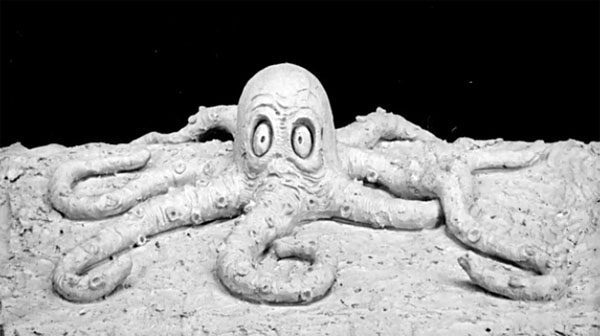
Willie Hopkins, Clay Pioneer. From The American Cinematographer June 1923, there was an article about Willie Hopkins who had done early clay animation in films from 1916-1918 including a series called Miracles in Mud for the Universal Film Magazine. “The animation of clay brings together one of the oldest of arts and one of the newest of arts for the entertainment of contemporary audiences. The arts, of course, are sculpture and of motion picture.
“Hopkins has learned that a clean light-colored clay found in Placer County, Calfiornia best lends itself to animated work. This, a form of pottery clay, does not produce hilattion to any marked degree and hence does not work against effective lighting. Clay that is too fresh or wet cannot be used, as it does not, when worked into figures, stand up long enough to permit filming but sinks, slides and falls. The filming of the various positions requires attention to minute details.
“When he began his experiments, Hopkins working in a studio well lighted with daylight in Dallas, Texas where he conceived the idea, used a primitive motion picture camera and did all the shooting himself.
“Hopkins’ subjects of clay animation range from crawling worm to a speeding locomotive. His experience is that the public is most interested in humorous changes of expressions on a human face.
“On one occasion, Hopkins stood in a cage with five lions at Universal City, California and modeled for animations the head of the lion ‘Bobby’ while a film was taken of the entire proceedings. The film was later released by the Three companies, Universal, Parmount and Pathe have released Hopkins’ clay subjects. He also achieved successful results in lettering on clay backgroungs, using water-color white for the letters proper and shading with lampblack.”
 The Rugrats Movie. The Rugrats Movie (1998) based on the Nickelodeon television series was co-directed by Norton Virgien. Two episodes of Rugrats that won Emmy Awards were directed by Virgien. He said when the film was first released: “Most of us who worked on the first season all had little babies about the Rugrats ages at home. That’s what we knew at the time. That made it a lot different from many of the shows that are kind of genre shows about superheroes or cats and mice.
The Rugrats Movie. The Rugrats Movie (1998) based on the Nickelodeon television series was co-directed by Norton Virgien. Two episodes of Rugrats that won Emmy Awards were directed by Virgien. He said when the film was first released: “Most of us who worked on the first season all had little babies about the Rugrats ages at home. That’s what we knew at the time. That made it a lot different from many of the shows that are kind of genre shows about superheroes or cats and mice.
“So many people that have tried animation outside of Disney have followed the template to such a degree that it’s hard to tell them apart. Thankfully, the show had proved itself to the degree that Paramount and Nickelodeon were willing to let us continue playing to the strength of Rugrats on television.
“I started work at Hanna-Barbera in the 1970s and this was very different. We did a show entirely in crayon to show the characters’ imagination bringing their crayon drawings to life. The chance of us doing that when I was working at Hanna-Barbera was zero. If you look back at the days when Scooby-Doo was about the best thing being done, it was pretty sad. It was a very discouraging field for a while.”
Betty Lou Gerson. Actress Betty Lou Gerson who passed away in January 1999 was the voice for Disney’s Cruella DeVille. “I got the idea she had become a kind of cult figure when I went to my manicurist. Her niece had an English boyfriend and when he heard I was there, he came over specifically to meet Cruella.” Few remember she was also the narrator for Disney’s Cinderella (1950) and had a small cameo as an old crone in Mary Poppins (1964). Although she retired in 1966, she did one last cartoon voice as Frances Albacore the fish in Cats Don’t Dance (1997).
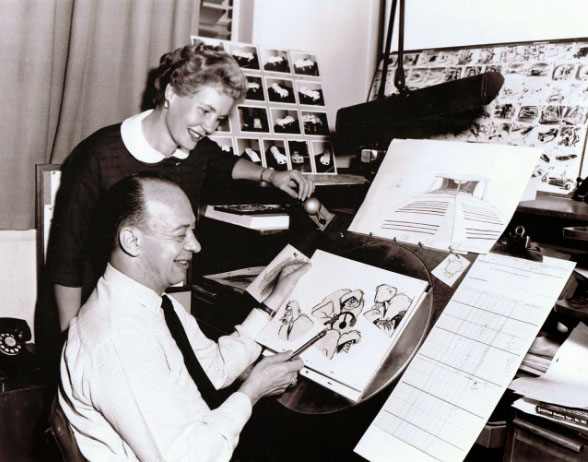
Disney animator, Marc Davis, and Betty Lou Gerson, the voice of Cruella de Vil.
 A Group Effort. From The Comics Journal April 1991, The Simpsons’ Matt Groening said, “The Simpsons is a group effort and I can talk about The Simpsons with great enthusiasm because I feel like I’m talking about everybody’s work on the show: the writers, the animation directors, the actors have all contributed so much to making this show funny and a joy to work on. (Producer James L.) Brooks at the very beginning said his ambition for the show was to maintain an emotional reality that was not cartoony, the goal being to make people forget that they were watching a cartoon.
A Group Effort. From The Comics Journal April 1991, The Simpsons’ Matt Groening said, “The Simpsons is a group effort and I can talk about The Simpsons with great enthusiasm because I feel like I’m talking about everybody’s work on the show: the writers, the animation directors, the actors have all contributed so much to making this show funny and a joy to work on. (Producer James L.) Brooks at the very beginning said his ambition for the show was to maintain an emotional reality that was not cartoony, the goal being to make people forget that they were watching a cartoon.
“The other executive producer Sam Simon had worked in animation and he understood the peculiar aspects of animation that made it different from a live action show. I predict that in a few years, the list of animators, directors and writers who worked on the show will read like a roll-call of the great TV and movie makers of the 1990s and beyond. There’s a lot of really good stuff that I didn’t draw but that looks like I did. I have a very simple look to my characters and by following certain rules, it’s very easy for people to imitate my style.”
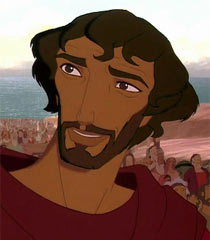 Val Kilmer is Moses. In the Daily News January 3rd, 1999, actor Val Kilmer talked about doing the voice of Moses in Dreamworks Prince of Egypt (1998): “On a personal note, my little brother who died knew the head of special effects at Disney. Nobody knew how since he was only 14 or 15. He was quite a brilliant kid and was just obsessed with animation. It was a way to honor my brother. In addition I have a seven year old daughter who goes to Sunday school and loves saying, ‘My daddy’s Moses’.
Val Kilmer is Moses. In the Daily News January 3rd, 1999, actor Val Kilmer talked about doing the voice of Moses in Dreamworks Prince of Egypt (1998): “On a personal note, my little brother who died knew the head of special effects at Disney. Nobody knew how since he was only 14 or 15. He was quite a brilliant kid and was just obsessed with animation. It was a way to honor my brother. In addition I have a seven year old daughter who goes to Sunday school and loves saying, ‘My daddy’s Moses’.
“Recording the voice is such an alien envrionment. Jeff (Katzenberg) would use storyboards and pointers and give very specific directions and I thought, ‘Why are you doing this? I get the idea’. Then I realized why. There is nothing else to go by. It’s really out there. They turn out he lights. (Actor Ralph) Fiennes played my brother and he recorded his scenes at different times and thousands of miles away.”
Credit Where It Is Due. In a letter to the editor published in Daily Variety December 11th, 1987, producer and animator Chuck Jones wrote, “I appreciate the compliment of being called in Daily Variety (December 3) the ‘creator’ of Bugs Bunny but Bugs is an unusual rabbit. Instead of having many children, he had many fathers. My co-sires: Tex Avery, Friz Freleng, Bob Clampett and Bob McKimson. After all, being the father of a coyote, a roadrunner and a skunk is burden enough.”
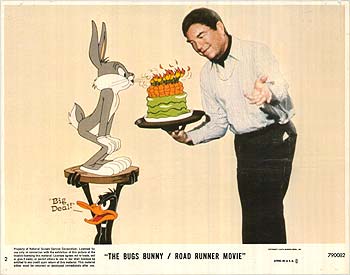


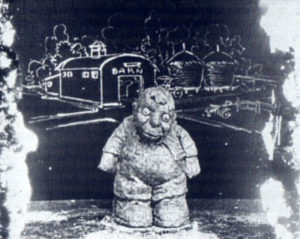
 Jim Korkis is an internationally respected animation historian who in recent years has devoted his attention to the many worlds of Disney. He was a columnist for a variety of animation magazines. With his former writing partner, John Cawley, he authored several animation related books including The Encyclopedia of Cartoon Superstars, How to Create Animation, Cartoon Confidential and Get Animated’s Animation Art Buyer’s Guide. He taught animation classes at the Disney Institute in Florida as well as instructing classes on acting and animation history for Disney Feature Animation: Florida.
Jim Korkis is an internationally respected animation historian who in recent years has devoted his attention to the many worlds of Disney. He was a columnist for a variety of animation magazines. With his former writing partner, John Cawley, he authored several animation related books including The Encyclopedia of Cartoon Superstars, How to Create Animation, Cartoon Confidential and Get Animated’s Animation Art Buyer’s Guide. He taught animation classes at the Disney Institute in Florida as well as instructing classes on acting and animation history for Disney Feature Animation: Florida.




















































Before his final transformation into Colonel Sanders, Chuck Jones briefly appropriated the guise of Seventies-era Jerry Lewis.
What a great observation!! :o) Hilariously astute!!
Really surprised that Chuck Jones gave credit to Bob Clampett in his 1987 letter to the Daily Variety. Was he afraid of being called out if he didn’t?
The reason Jones gave credit to Bob Clampett in that letter to Variety was likely because Clampett was dead by then and no longer in a position to claim credit, or excessive credit , for anything having to do with the origins of the Warner Bros. cartoon characters. Not that I’m saying Clampett was guilty of that, but some of his former co-workers believed he was.